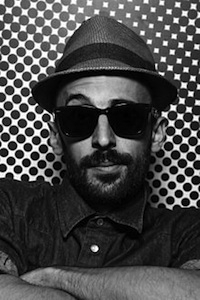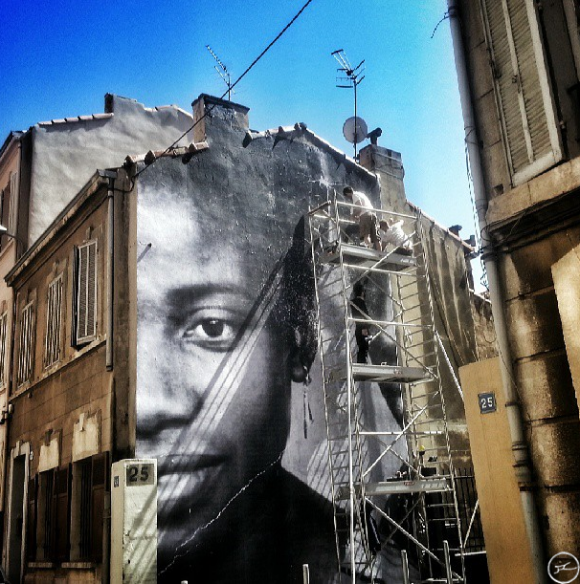The artist known as JR: Photography as activism, from Tunisia to Marseille
posted Wednesday, July 31, 2013 at 11:08 PM EST

Photographer and artist JR claims that he owns the largest art gallery in the world, a statement that is pure JR because his art gallery is the world. He's a provocateur who believes that photography can be an agent for social change, and he brings his art directly to us in the cities and streets where we live, work and play.
JR calls himself a "photograffeur," a term he invented to describe his creative work that merges photography and graffiti. He collects photos -- some taken by himself, some by his team, some contributed by local photographers and citizens -- enlarges them, and then plasters (or, technically, flyposts) them on public buildings in locales of his choosing. Often illegally. To me, he is a hyper-enthusiastic force of nature whose belief in the power of photographs to bridge social and political conflicts appears to be limitless.
Unframed in Marseille
This year, JR has been in my neck of the woods, having chosen the city of Marseille, France, as one of the canvases in his global gallery. Marseille happens to be 2013's "European Capital of Culture," a somewhat unexpected honor for what is arguably France's most violent city. But the European Union chooses its culture capitals thinking that the activities it funds for a city will function as a catalyst for its improvement. And Marseille certainly fits JR's modus operandi as an artist and activist.

Unframed, Marseille, France, Copyright 2013 JR
Whether or not the designation will change Marseille is yet to be seen, for its problems run deep. A beautiful port city on the Mediterranean, it is plagued by drugs, gangs and guns. Execution style murders and attacks on the police have become commonplace in its immigrant neighborhoods. JR chose one of these neighborhoods of North African immigrants as the site for his Marseille project, which he calls Unframed. The exhibition started in May and will run through November 2013 at La Friche at La Belle Mai, which is an abandoned factory (Friche translates to "wasteland") that's been recently converted into an art center. If you have the chance to visit Marseille before this project ends, I highly recommend you do so -- JR's work is truly a sight to behold in person.

Unframed, Marseille, France, Copyright 2013 JR
For Unframed, JR invited Marseille's residents to look through their personal family albums and find photographs that evoked strong memories of their lives there. He collected these images -- both old and recent ones -- and then cropped them and enlarged them, creating a monumental artwork on the walls of the neighborhood, transforming these personal memories into part of their collective history.

Unframed, Marseille, France, Copyright 2013 JR
Regarding one image (shown below) he used in his Marseille exhibit, JR shared this story with his Facebook fans (pardon his English):
"I went and look(ed) in the photographic archives of the city of Marseille and went across thousands of photos. I found this photo taken in the 1960 in Marseille of (some) anonymous women. With the help of La Friche art center and my team, we reconnected with a woman who (had) forgotten this photo was ever made of her by her best friend. She told (me) her story, how she immigrated to Marseille like thousands of (other) people... I hope this image will find her place in the heart of the people there and maybe, who knows, (it) will help people getting to know each other as we are all foreigners (in) another place at the end..."

Unframed, Marseille, France, Copyright 2013 JR
Exactly who is JR?
That's a good question. Born in France in 1983, JR is an enigma. His actual identity and past is unknown, yet today he is a highly public, highly visible artist. You could call him semi-anonymous.
JR began his photographic career as a street photographer after finding a camera in the Paris Metro. With this found camera he set out to photograph the "thugs" of the notorious banlieues (suburbs) of Paris. These images were pasted on the walls of Paris's upper class neighborhoods. Later dubbed 28 Millimeters - Portraits of a Generation, this illegal art project was so successful that Paris City Hall itself ended up officially wrapped in JR images.

28 Millimeters, Portrait of a Generation, Paris, France, Copyright JR
Portraits was followed by Face 2 Face, a series of distorted wide-angle portraits of laughing -- and rather goofy looking -- Israelis and Palestinians. He enlarged these images and pasted them on the security wall built between Israel and Palestine.

Face 2 Face, Israel/Palestine, Copyright JR
JR is probably best know for Inside Out, aka The People's Art Project, or what he calls an "Art and Act." For an Inside Out exhibit -- which have sprung up all around the globe -- JR often asks local photographers to send him their portraits of the people in their community. He then selects the images he likes and has hundreds of poster-sized black-and-white copies printed on ordinary paper. These are sent back to the photographers with the proviso that they be posted on every available public space they can find.

Inside Out, Times Square, New York City, Copyright JR
But, as always, the heart of JR's imagery is portraiture. Faces are central to his work and whether he employs video projection such as he did in New York City's Times Square last May or flypostings writ large in Berlin, Germany, JR wants us to look each other in the eye and realize our human commonality.

Inside Out, Berlin, Germany, Copyright JR
Art (and photography) as activism
As a photographer, I find Unframed, and all the other permutations of JR's Inside Out projects, exhilarating because it takes photography out of dimly lit salons, galleries and museums and out into the sunshine of everyday life. It puts street photography back in the street. Moreover, Inside Out shows are not inert exhibits, but often have become part of the events shaping the 21st century.
For example, JR visited Tunisia in early 2011, just as the "Arab Spring" began there. He recruited dozens of photographers who took thousands of photos of ordinary Tunisians. The enlarged paper portraits he made were sent back to Tunisia and pasted on top of the pervasive pictures of long time Tunisian dictator Zine El Abidine Ben Ali.

Inside Out, Tunisia, Copyright JR
Whether these images played a role in bringing down Ben Ali or not, one thing is certain: These thousands of portraits of ordinary Tunisians were a powerful counterpoint to Ben Ali's "cult of personality" images that filled Tunisians' visual space. JR's Inside Out project, I think, helped give the Tunisian people a sense of their own identity and helped to unite them.
For me, that's a pretty good rebuttal to the doomsayers who try to tell us photography is dead. Photography is part of the human spirit, and for JR and many other working photographers and artists (including me!), it is a tool of hope that will never die.
In 2011, JR received a $100,000 TED Award for his Inside Out project and spoke at TED2011. You can watch his audacious speech here (embedded below), and see his vision for turning the world Inside Out. You can also read more about JR, and see a full range of his artistic work at www.jr-art.net.